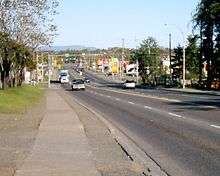Old Dawson Trail
The Old Dawson Trail is the remnant of the first all-Canadian route that linked the Great Lakes with the Canadian prairies. It was a water and land route that began at Fort William (now Thunder Bay, Ontario) and ended at St. Boniface (now Winnipeg, Manitoba). The land portions of the trail are usually referred to as Dawson Road.
Planning
In 1857, the Canadian government commissioned engineer Simon J. Dawson to survey a route from Lake Superior to the Red River Colony, thereby allowing travel from the east without having to take the existing routes through the United States. Dawson surveyed the route in 1858 and construction began in 1868. The entire trail, including the roads, was completed in 1871 and afterwards named after Dawson.[1][2]
Route
The Dawson Trail started as a road heading northwest from Fort William along the Shebandowan River, up to Shebandowan Lake. From there, the trail followed a series of lakes and rivers heading west, eventually ending up at the Rainy River and Lake of the Woods along the International Boundary. After crossing Lake of the Woods, the trail continued at Northwest Angle overland to Ste. Anne and then to its end at St. Boniface. The total distance of the trail was approximately 530 miles (853 kilometers). Travellers were required to load and unload their freight as many as 70 times throughout the journey.[2][3]
Use
Before the route was completed, the Wolseley Expedition used the trail to reach the Red River Colony and quell the Red River Rebellion of 1870. This rebellion led to the establishment of the Province of Manitoba later that year. In 1873, the Dawson route was used by some 1,600 people, however, most people still preferred to use the southern route through Duluth and Emerson, which was a much easier journey. After the completion of the railroad between Fort William and Winnipeg in the 1880s, much of the Dawson Trail was abandoned, although local residents continued to make use of the roads.[4]
Today

Segments of the Old Dawson Trail are still in use today in both provinces. Ontario Highways 102 and 11 follow Dawson Road from Thunder Bay to Shebandowan. From there, Highway 11 generally follows the original water route west to Rainy River.
In Manitoba, the stretch from Northeast Angle to Richer is no longer used and has fallen into disrepair, but is still accessible via the Trans-Canada Highway from the north and Provincial Road 308 from the east. Between the communities of Richer and Lorette, Dawson Road has been incorporated into Provincial Road 207. In the city of Winnipeg, sections of Dawson Road are still actively used and bear the original name, but have been disconnected since the construction of the Red River Floodway and Lagimodiere Boulevard.
A cairn and plaque commemorating the Dawson Road was erected by the Historic Sites and Monuments Board of Canada in 1933. The landmark is located next to the local municipal office in Ste. Anne, Manitoba.[2]
References
- ↑ "Dawson Road". Marianapolis College. April 2005. Retrieved 4 September 2012.
- 1 2 3 "Dawson Road Plaque (Ste. Anne)". Manitoba Historical Society. March 2012. Retrieved 4 September 2012.
- ↑ "Manitoba Heritage Council Commemorative Plaques-Dawson Road". Government of Manitoba. Retrieved 4 September 2012.
- ↑ "Dawson Road". The Canadian Encyclopedia. Retrieved 4 September 2012.
External links
- Manitoba Historical Society; The Red River Cart and Trails
- Map of Route Between Lake Superior and Red River Settlement (1869)
- Dawson Road Map
- Plan of Dawson Road from Thunder Bay to Lake Shebandowan (1871)